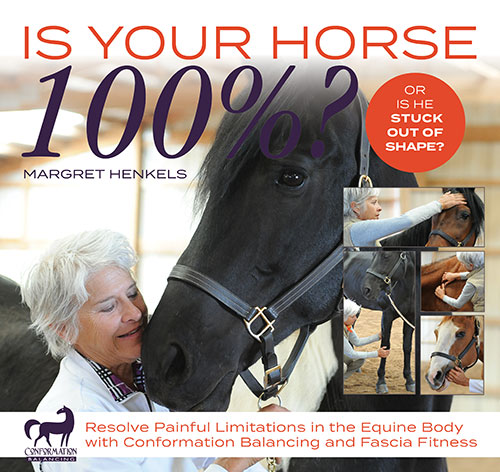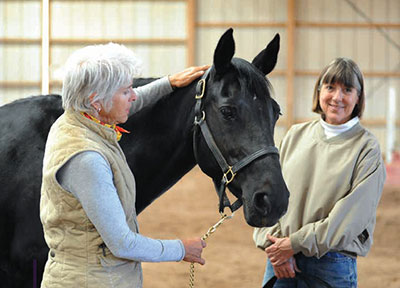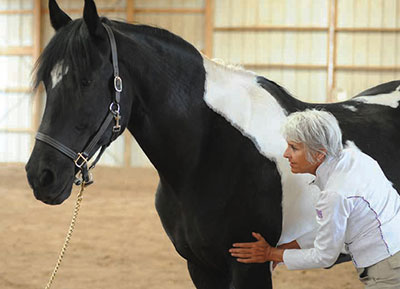
by Margret Henkels
Clients often ask me how I got into horse myofascial bodywork. A passion for horses, and my own personal experience of being completely healed, brought me to this work—Conformation Balancing. A riding fall at 28 brought chronic injuries lasting years. I knew nothing about fascia (connective tissue) and its role in organizing the entire body. A synchronicity at a horse show introduced me to Steve Evans, a Heller Work practitioner. Heller Work is an offshoot of Rolfing and trains people in its particular approach to fascia. The weekly myofascial-release sessions transformed me into fitness. Each week, for 15 weeks, I drove to Taos where Steve lived and returned feeling better. I loved the changes I felt and the work itself. My experience is that Heller Work is much less strenuous tissue work and is comfortable for the patient, even in the first session, unlike Rolfing, which is known to be strenuous.
On his table, I talked about my horses often and told him stories of my rides. Steve suggested I consider getting into the horse bodywork field. “Just what I need, another startup,” I said with a laugh. His suggestion seed grew. The changes I felt transformed my goals. Paperwork and financial data of the business world lost their charm. I felt amazingly better and fit enough to work with horses. He referred me to Equine Natural Movement, Heller for Horses, in Battle Ground, Washington, where I took a module of training, before certifying.
In myofascial-release training, I heard the call of the physical world. And, I learned something completely new: how hidden feelings surface when myofascial cells open as they release compression, and in the process, release trauma that has been held in the body. The emotional and spiritual transformations that occurred during myofascial change fascinated me: this clearing of trauma by bodywork is part of the amazing miracle of myofascial change. In sessions with horses, I watched horses change emotionally and trust me. Horses in pain wanted help.
As it turned out, I focused on solving long-term problems for horses. Horses with elusive, painful disabilities arrived to advance my experience. These talented horses with difficult imbalances challenged me in each session as the horses and I explored their blockages to fitness. Since I knew it was possible to regain 100 percent fitness, I communicated this understanding to them. An anxious horse is a fearful horse, and if we take no notice of his anxiety, or call it laziness or a bad attitude, a horse acts out to save his life, and the dance of dangerous dysfunction begins for the rider—or anyone else working with the horse.
I became very interested in why so many horses didn’t look fit. Patterns revealing how these horses became limited and miserable emerged. Digital photos became part of my work and I designed body maps to record the progress. I enjoyed the transformation these horses showed as they returned to fitness and productive lives. The riders were delighted.


Since efficiency in this process is vital, I studied the patterns and the appearances of the horses. Over time, the body limits matched up with certain physical looks, despite the breed, age, or work. My form of fascia fitness bodywork called Conformation Balancing developed from this process of looking at the horse’s conformation and finding his imbalances. It was a major discovery to realize how little genetics or perfect situations could prevent a horse’s decline when he had a strain and an accident. The horses were well bred and well trained, but their conformation was unbalanced. The decline in these injured horses mystified their riders. The painful “soft-tissue” problem forces many well-trained and talented horses into a state of idleness, a great loss for both horse and rider.
Like humans, horses are joyful when expressing their gifts and talent. Horses need help for loss of fitness, including their lost happiness as horses, for when a horse isn’t fit, he’s caught in a primal, cellular panic, fearful that a predator will get him. A numbed state of resistant fear is not a happy life for a horse. Conformation Balancing was developed to offer tools that any motivated rider can learn to end this cycle of limitation and eruptions of fear by the horse.
Our lives as riders depend upon our horses’ mental balance and cooperation. Conformation Balancing emphasizes the “Still Point” change for this reason: the Still Point occurs when the horse turns his attention inward as we work with his body to follow his body’s myofascial changes. His eye looks very focused and intense as he feels change happening in his tissue. These Still Point changes bring emotional and physical relief. He feels the change and recognizes it as an improvement. These cellular changes are unique to the myofascial-change process.
As riders know well, the horse’s emotional experience often rules the day; the importance of the change for the horse in a Still Point is beyond words. Best of all, the myofascial-release methods bring effective, lasting progress and relief. As with humans, this relief from pain lifts the horse’s spirits. The inner change of emotional, physical, and spiritual progress brings him into a new fitness. Since we are offering him relief, a new trust grows. I truly believe that we are on a threshold of change now for horses and humans. The horse’s desire is slowly being included in our plans, which is a welcome move forward in the horse/human relationship.
This excerpt from Is Your Horse 100%? by Margret Henkels is reprinted with permission from Trafalgar Square Books (www.horseandriderbooks.com). Find this book and more in our Entertainment section.

































